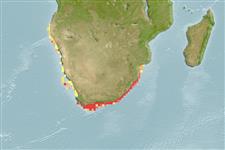Elasmobranchii (tubarões e raias) (sharks and rays) >
Myliobatiformes (Stingrays) >
Dasyatidae (Stingrays) > Dasyatinae
Etymology: Dasyatis: Greek, dasys = rough, dense (Ref. 45335).
Issue
Distribution needs review.
Environment: milieu / climate zone / depth range / distribution range
Ecologia
marinhas demersal; intervalo de profundidade 1 - 110 m (Ref. 114953). Tropical; 15°S - 36°S, 10°E - 34°E (Ref. 114953)
Southeast Atlantic: central Angola to at least St. Lucia, Natal, South Africa, possibly extending to Mozambique. Reported from the Comoros, Reunion and Madagascar (Ref. 33390).
Tamanho / Peso / Idade
Maturity: Lm ? range ? - ? cm
Max length : 75.0 cm WD macho/indeterminado; (Ref. 36731)
Found in shallow bays, sheltered sandy beaches in summertime, moves to deeper waters during winter. Feeds on bony fishes and crustaceans such as crabs, shrimps and mantis shrimps (Ref. 36731); including sea lice and marine worms (Ref. 114953). Ovoviviparous (Ref. 50449). Litters of 1-5 pups (Ref. 114953). Often caught by shore anglers (Ref. 36731). It is parasitised by the monogenean Dendromonocotyle citrosa on the dorsal skin surface (Ref. 124058).
Life cycle and mating behavior
Maturities | Reprodução | Spawnings | Egg(s) | Fecundities | Larvas
Exhibit ovoviparity (aplacental viviparity), with embryos feeding initially on yolk, then receiving additional nourishment from the mother by indirect absorption of uterine fluid enriched with mucus, fat or protein through specialised structures (Ref. 50449). Distinct pairing with embrace (Ref. 205).
Cowley, P.D. and L.J.V. Compagno, 1993. A taxonomic re-evaluation of the blue stingray from southern Africa (Myliobatiformes: Dasyatidae). S. Afr. J. Mar. Sci. 13:135-149. (Ref. 33465)
Categoria na Lista Vermelha da IUCN (Ref. 130435)
Ameaça para o homem
Harmless
Utilização humana
Pescarias: espécies comerciais; Aquário: Espécies comerciais
Ferramentas
Relatórios especiais
Descarregue XML
Fontes da internet
Estimates based on models
Preferred temperature (Ref.
123201): 17.2 - 26.7, mean 24.8 °C (based on 64 cells).
Phylogenetic diversity index (Ref.
82804): PD
50 = 0.5002 [Uniqueness, from 0.5 = low to 2.0 = high].
Bayesian length-weight: a=0.00646 (0.00265 - 0.01571), b=3.06 (2.86 - 3.26), in cm total length, based on LWR estimates for this (Sub)family-body shape (Ref.
93245).
Nível Trófico (Ref.
69278): 3.8 ±0.65 se; based on food items.
Generation time: 15.7 ( na - na) years. Estimated as median ln(3)/K based on 1
growth studies.
Resiliência (Ref.
120179): Baixo, tempo mínimo de duplicação da população 4,5 - 14 anos (Assuming fecundity<100).
Fishing Vulnerability (Ref.
59153): Very high vulnerability (78 of 100).
